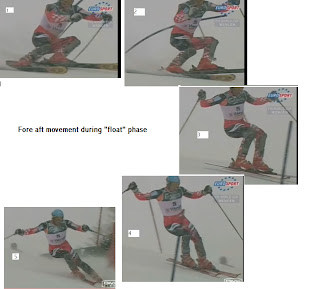If you are an athlete involved in alpine ski racing you have probably heard at one time a coach tell someone to move more forward. What this means is that the athlete is struggling with their fore aft balance. In dynamic skiing, there is a shift in pressure that happens along the length of ski as one carves a turn. As you enter the "carving part" of a turn the pressure is shifted to the front of the skis in order to engage the tips of the skis. Then as the carve progresses the pressures shifts from the front of the skis to the back of the skis. This shift in pressure allows the skier to maintain their speed throughout the turn. To allow this type of pressure shift, the skier must actively adjust their upper body postion with respect to their lower body or feet position. This can be accomplished in two ways: shifting the feet back and forward, or moving the upper body forward and backwards. On very flat terrain it feels like a rocking motion, especially when exaggerated. If a coach has ever told you to move forward more, it may mean one of two things: either you are skiing in the "backseat" with the pressure on the tails of your skis during all phase of the turn, or you aren't allowing the pressure to shift back at the end of the turn. The difficult part of understanding how to perfect your fore aft balance is to understand when and how you shift the pressure from the front of the skis to the back of the skis. This is what I will try to explain in detail. In a carved turn, there are two basic stages: The "float" stage and the "bite" stage. The "float" stage of the turn is the part of the turn where there isn't a lot of pressure on the skis with respect to their contact with the snow. At this stage you feel "light" on your feet and your skis may not even have contact with the snow. This is also sometimes called the "unweighting" stage. In dynamic skiing this is also where you would be releasing the pressure from the previous turn, finding your ski platform to set up for the new turn, and pivoting your feet to create a direction change. The time spent in this stage depends on the type of arc you need to create to maintain a good line. This stage is also where you might use "drifting" if it is required to maintain a good line. The second stage of the turn is called the "bite stage." In this stage the skis are in contact with the snow and you are applying pressure to the ski to get the ski to bend and create an arc without pivoting. In this stage the racer may also be using pressure and impulse to generate speed and accelerate out of the turn. The time spent in this stage also depends on the type of arc required. It is important to divide the turn into these two phases to understand how to perfect fore aft balance. In the carve stage the pressure shifts from the front of the skis to the back of the skis. So when a skier finishes their turn, the weight or pressure will be on the back or tails of the skis. During the carve phase however, the pressure needs to be at the front of the skis at the beginning, for this reason the skier must actively shift their weight from the tails of the skis to the front of the skis, and this shift must happen in the "float" stage. Lets look closely at an example of world cup skiing.
Fore aft movement during float phase
Notice in the photo above that the skier makes an abrupt movement to bring their weight forward to engage the tips of the skis in preparation for the carve phase of the turn which is shown in the photo below. Note that the carve phase is shown at the opposite gate because the camera provided a better angle at the next gate for frame shots.
Pressure shift during "bite" phase
Notice where the snow is coming off the skiis in each frame above. This gives an indication where the pressure is on the ski with respect to the snow. In the first frame the snow is coming off the tips where as in the last frame it is coming of the tails of the skis.


No comments:
Post a Comment